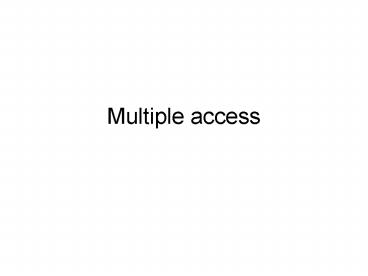Multiple access - PowerPoint PPT Presentation
Title:
Multiple access
Description:
Multiple access CDMA Encode/Decode CDMA: two-sender interference Random Access Protocols When node has packet to send transmit at full channel data rate R. no a ... – PowerPoint PPT presentation
Number of Views:234
Avg rating:3.0/5.0
Title: Multiple access
1
Multiple access
2
(No Transcript)
3
(No Transcript)
4
(No Transcript)
5
(No Transcript)
6
CDMA Encode/Decode
channel output Zi,m
Zi,m di.cm
data bits
sender
slot 0 channel output
slot 1 channel output
code
slot 1
slot 0
received input
slot 0 channel output
slot 1 channel output
code
receiver
slot 1
slot 0
7
CDMA two-sender interference
8
(No Transcript)
9
(No Transcript)
10
(No Transcript)
11
(No Transcript)
12
(No Transcript)
13
(No Transcript)
14
(No Transcript)
15
Random Access Protocols
- When node has packet to send
- transmit at full channel data rate R.
- no a priori coordination among nodes
- two or more transmitting nodes -gt collision,
- random access MAC protocol specifies
- how to detect collisions
- how to recover from collisions (e.g., via delayed
retransmissions) - Examples of random access MAC protocols
- slotted ALOHA
- ALOHA
- CSMA, CSMA/CD, CSMA/CA
16
Slotted ALOHA
- Cons
- collisions, wasting slots
- idle slots
- nodes may be able to detect collision in less
than time to transmit packet
- Pros
- single active node can continuously transmit at
full rate of channel - highly decentralized only slots in nodes need to
be in sync - simple
17
Slotted Aloha efficiency
- For max efficiency with N nodes, find p that
maximizes Np(1-p)N-1 - For many nodes, take limit of Np(1-p)N-1 as N
goes to infinity, gives 1/e .37
Efficiency is the long-run fraction of
successful slots when theres many nodes, each
with many frames to send
- Suppose N nodes with many frames to send, each
transmits in slot with probability p - prob that 1st node has success in a slot
p(1-p)N-1 - prob that any node has a success Np(1-p)N-1
At best channel used for useful transmissions
37 of time!
18
Pure (unslotted) ALOHA
- unslotted Aloha simpler, no synchronization
- when frame first arrives
- transmit immediately
- collision probability increases
- frame sent at t0 collides with other frames sent
in t0-1,t01
19
Pure Aloha efficiency
- P(success by given node) P(node transmits) .
- P(no
other node transmits in p0-1,p0 . - P(no
other node transmits in p0-1,p0 - p .
(1-p)N-1 . (1-p)N-1 - p .
(1-p)2(N-1) - choosing optimum
p and then letting n -gt infty ... -
1/(2e) .18
Even worse !
20
CSMA (Carrier Sense Multiple Access)
- CSMA listen before transmit
- If channel sensed idle transmit entire frame
- If channel sensed busy, defer transmission
- Human analogy dont interrupt others!
21
CSMA collisions
spatial layout of nodes
collisions can still occur propagation delay
means two nodes may not hear each others
transmission
collision entire packet transmission time wasted
note role of distance propagation delay in
determining collision probability
22
CSMA/CD (Collision Detection)
- CSMA/CD carrier sensing, deferral as in CSMA
- collisions detected within short time
- colliding transmissions aborted, reducing channel
wastage - collision detection
- easy in wired LANs measure signal strengths,
compare transmitted, received signals - difficult in wireless LANs receiver shut off
while transmitting - human analogy the polite conversationalist
23
CSMA/CD collision detection
24
Taking Turns MAC protocols
- channel partitioning MAC protocols
- share channel efficiently and fairly at high load
- inefficient at low load delay in channel access,
1/N bandwidth allocated even if only 1 active
node! - Random access MAC protocols
- efficient at low load single node can fully
utilize channel - high load collision overhead
- taking turns protocols
- look for best of both worlds!
25
Taking Turns MAC protocols
- Token passing
- control token passed from one node to next
sequentially. - token message
- concerns
- token overhead
- latency
- single point of failure (token)
- Polling
- master node invites slave nodes to transmit in
turn - concerns
- polling overhead
- latency
- single point of failure (master)
26
Summary of MAC protocols
- What do you do with a shared media?
- Channel Partitioning, by time, frequency or code
- Time Division,Code Division, Frequency Division
- Random partitioning (dynamic),
- ALOHA, S-ALOHA, CSMA, CSMA/CD
- carrier sensing easy in some technologies
(wire), hard in others (wireless) - CSMA/CD used in Ethernet
- Taking Turns
- polling from a central site, token passing
27
(No Transcript)
28
(No Transcript)

